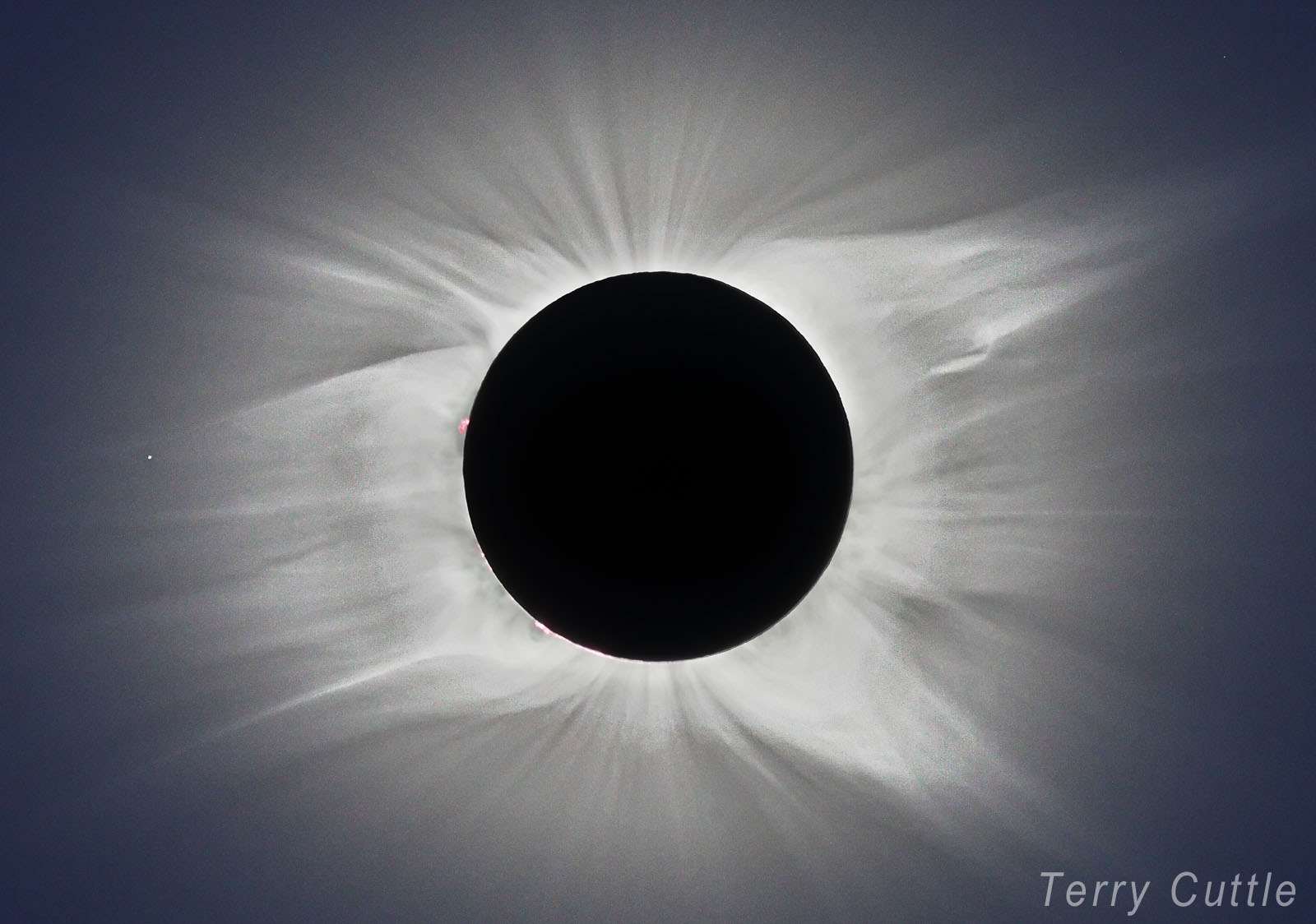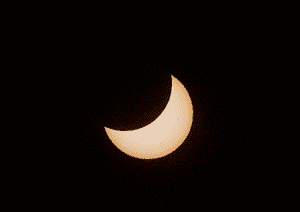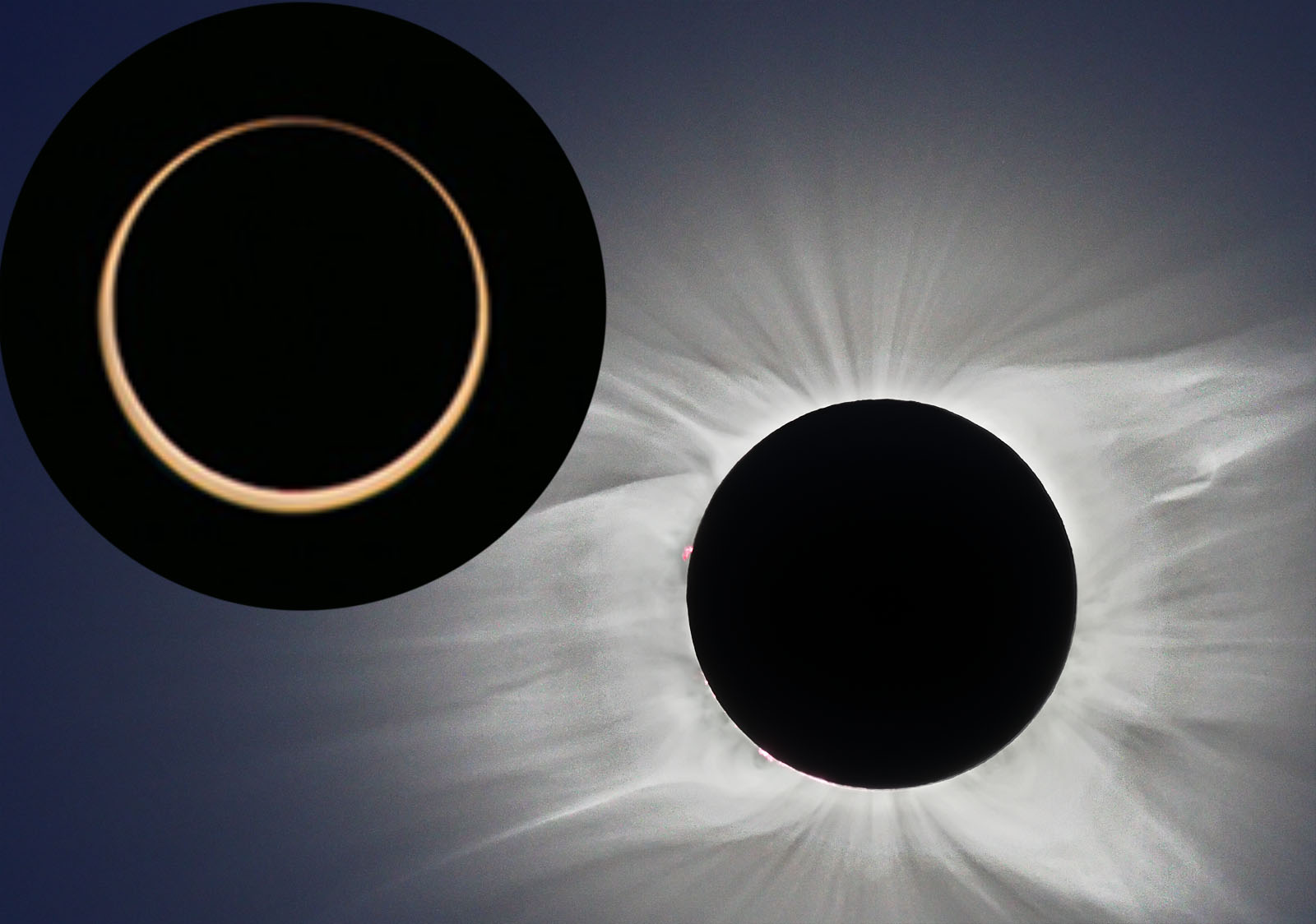COUNTDOWN TO TOTALITY* 22.07.28
Day(s)
:
Hour(s)
:
Minute(s)
:
Second(s)
What Are Eclipses?
Eclipse \i klips′\ (n): the total or partial obscuring of one heavenly body by another.
— Merriam-Webster Online Dictionary
A total solar eclipse is a rare event, cosmically speaking. There are more than 200 confirmed moons orbiting six major planets in our solar system (Mercury and Venus lack moons). But in only one instance is there a moon that’s the right size, and at the right distance from its planet, to just barely cover the brilliant solar disk and reveal the Sun’s wispy corona.
And that’s our Moon.
Looked at another way, total solar eclipses aren’t rare; they occur roughly once every year or two somewhere on Earth. But any given spot on our planet’s surface gets darkened by the Moon’s shadow on average only once about every 400 years (but this varies widely), so in that sense totality is indeed rare.
The Moon orbits Earth, and Earth orbits the Sun. But they are not all in exactly the same plane. That is why there is not an eclipse at every new moon.
The plane of Earth’s orbit around the Sun is called the ecliptic plane. The Moon’s orbit is inclined by about 5.1° to the ecliptic plane.
For an eclipse to occur, the Sun, the Moon and Earth must be exactly aligned. That alignment is called “syzygy”.

Most of the time, when the three bodies are close to the same line, the Moon is above or below the ecliptic plane. But roughly every 6 months there are points where the plane of the Moon’s orbit crosses the ecliptic plane at the point of alignment between the three bodies.
Those points are called “nodes” and that is where eclipses are possible. If the Moon is at the new moon position at that time, the Moon’s shadow can fall on Earth and a solar eclipse can occur.
If the Moon is at the full moon position at that time then the Moon can pass through Earth’s shadow and a lunar eclipse can occur when the Moon will look a dark Red due to refraction of light through Earth’s atmosphere.
A total eclipse does not occur at every crossing of a node as the new or full moon may not occur close to the time when Earth is at one of the nodes.
Types Of Eclipse
Cosmic Coincidence
The Sun’s diameter (1 393 000 km) is about 400 times the Moon’s (3 476 km). The Sun is also (on average) about 400 times further away (150 million km vs. 384 000 km). As a result, the two bodies appear almost exactly the same angular size in the sky — about ½°, roughly half the width of your little finger seen at arm’s length.
This truly remarkable coincidence is what gives us total solar eclipses. If the Moon were slightly smaller or orbited a little further away from Earth, it would never completely cover the solar disk. If the Moon were a little larger or orbited a bit closer to Earth, it would block much of the solar corona during totality, and eclipses wouldn’t be nearly as spectacular.
Of course the Moon doesn’t totally eclipse the Sun every month — if it did, seeing totality wouldn’t be such a rare treat. And even when the lunar disk encroaches on the Sun, it doesn’t always completely cover the solar disk. In fact, at new Moon — the only lunar phase when a solar eclipse can occur — the Moon usually misses the Sun altogether. Given all the variables, it’s almost surprising that we see eclipses at all.
A Celestial Dance
The Moon orbits Earth; both swing around the Sun. In a perfect universe, we’d see totality every month. But we don’t, and here’s why.
First, the apparent size of the Sun varies during the year because Earth’s orbit is an ellipse, not a perfect circle. Our planet is closest to the Sun (perihelion) in early January and farthest (aphelion) in early July.
So the Sun appears a little more than 3% larger in January than in July (not that you’d notice), which means at times it’s harder for the Moon to completely cover the Sun and create a total eclipse.
More dramatic is the change in the Moon’s apparent diameter due to its elliptical orbit around Earth. When the Moon is closest to Earth (perigee), its apparent diameter is on average a little more than 11% larger than when it’s farthest (apogee).
When near perigee, the Moon can easily cover the entire solar disk and create a total solar eclipse. But at apogee the Moon is too small to cover all of the Sun’s brilliant face. At mideclipse an annulus (ring) of sunlight surrounds the lunar silhouette, resulting in an annular eclipse.
But the variability in the apparent size of the Sun and Moon doesn’t preclude a monthly solar eclipse. What does limit eclipses is the tilt of the Moon’s orbit, which is about 5° to the plane of Earth’s orbit around the Sun or, equivalently, the Sun’s apparent path around the sky as seen from Earth.
This path is called the ecliptic, for reasons that will become obvious in a moment. More often than not, the new Moon passes above or below the Sun, and the lunar shadow misses the Earth completely.
But every 173.3 days (roughly every 6 months), the new Moon passes through one of two crossover points (nodes) where the Moon’s tilted orbit intersects the ecliptic.
Here, at last, a solar eclipse is possible. Of course the Moon can pass through a node without the eclipse being total or annular — a partial eclipse can occur instead. It depends how close the Sun is to the node when the Moon passes by.
Does this limit solar eclipses (of all types) to two each year? No, because the Sun remains close to each node for a little longer than a month.
This means that if the Moon crosses a node within the first few days of this period (called an eclipse season) and causes a solar eclipse, it can do so again a month later and create a second solar eclipse. So it’s possible to have two solar eclipses within a month of each other (on either side of the node), though both will be partials. If this happens again about six months later at the other node, there could be four solar eclipses (all partial) in a single year. This doesn’t happen very often. And, anyway, we’re more interested in annular and total solar eclipses, since they’re a lot more interesting (and, in the case of total eclipses, vastly more spectacular).
The complications don’t end there. The nodes slowly shift (precess) westward, which means the months in which eclipses take place slowly change as the years pass.
Finally, after 6,585.32 days (18 years, 11 days, 8 hours), the entire eclipse cycle repeats. This is known as the Saros cycle. When two eclipses are separated by a period of one Saros, the Sun, Earth, and Moon return to approximately the same relative geometry, and a nearly identical eclipse will occur (though the eclipse path will be shifted west by eight hours — one third of Earth’s daily rotation). After three such cycles, called an exigimos, a nearly identical eclipse will occur in the same part of the world where it did a little more than 54 years earlier.
Nothing Lasts Forever
The cosmic coincidence that gives us total solar eclipses isn’t permanent. The Moon is ever so slowly moving away from our planet at rate of about 3.8 centimetres (1.5 inches) per year. As it recedes, its average apparent diameter shrinks. Eventually, the Moon will never be large enough to completely cover the Sun, and total eclipses will no longer be visible from Earth’s surface.
And when might this sad prospect come to pass? The calculation is not precise — there are many unknowns such as whether the lunar retreat will continue at a constant rate and whether the solar diameter will remain stable over a long period of time. Still, about a billion years from now, give or take a few hundred million years, the surface of Earth will experience its final total eclipse of the Sun. Annular eclipses will continue to occur, though the percentage of the solar surface hidden by the Moon will gradually decrease.
So, when you stand in the lunar shadow watching the Moon pass between Earth and the Sun, revel in the knowledge that you are witnessing one of the most unusual and spectacular events in the cosmos.






